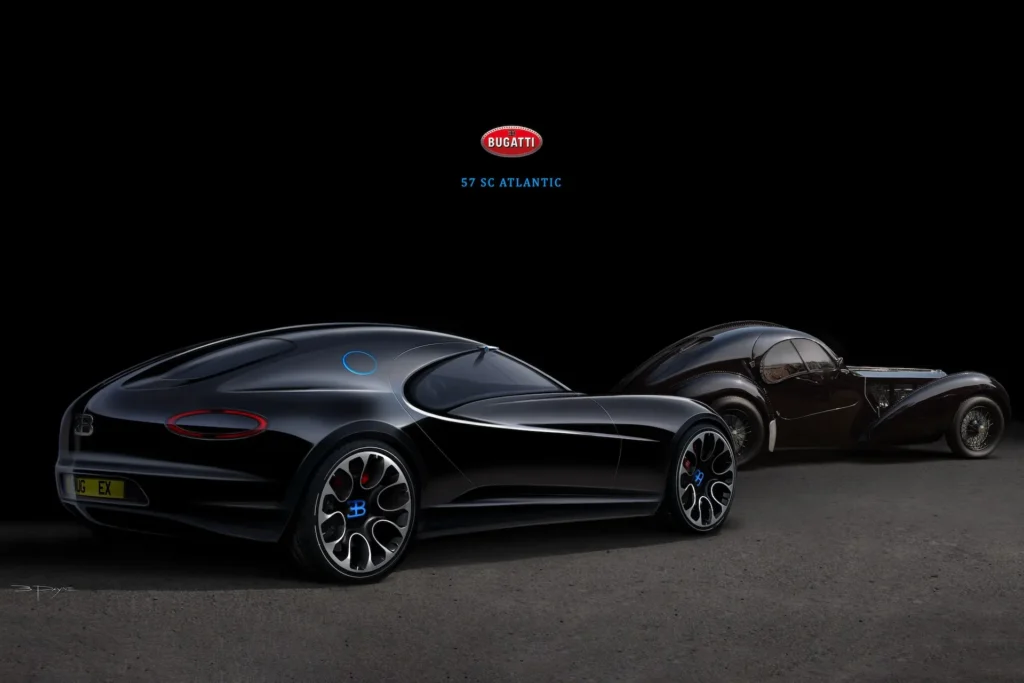Bugatti has always been synonymous with automotive excellence and avant-garde design, continually redefining the intersection of luxury and performance. The French automaker’s rich history has birthed some of the most iconic vehicles ever created, from the Type 35, a revolutionary race car of the 1920s, to the Type 57 Atlantic, an art deco masterpiece. In a recent revelation leading up to a seminar about Bugatti’s legacy, the automaker disclosed previously unseen design studies that explore the brand’s vision for a modern reinterpretation of these classics.
These studies, set to be showcased at the National Automuseum in Dietzhölztal, Germany, on November 8-9, provide a fascinating glimpse into Bugatti’s design philosophy and its reverence for historical aesthetics. The museum, home to the esteemed Loh Collection, will serve as an ideal setting to unveil these hidden gems, drawing enthusiasts and historians alike to appreciate the convergence of past and future in automotive design.
Reviving the Type 57 Atlantic Coupe
The original Bugatti Type 57 Atlantic Coupe, produced in the late 1930s, is celebrated for its streamlined bodywork, pronounced dorsal seam, and breathtaking proportions. It represented Jean Bugatti’s vision of elegance, featuring a sleek, elongated body reminiscent of aeronautical design principles. Each curve and line on the Atlantic Coupe was meticulously sculpted to enhance its aerodynamic performance while maintaining a striking aesthetic that would become synonymous with Bugatti’s design ethos.
In 2008, Bugatti flirted with the idea of reimagining this iconic model, envisioning a modern version of the Atlantic Coupe that would honor its heritage while incorporating contemporary design and engineering advancements. Although the project never materialized into a production model, the sketches and digital renderings from this period reveal a car that could have redefined luxury GT (grand tourer) styling for the 21st century.
The design studies showed an updated interpretation of the Atlantic’s teardrop-shaped cabin and sweeping fenders, coupled with a refined grille and signature horseshoe design. This homage to the original maintained the split windshield and central spine—an unmistakable feature of the Type 57. However, the new model proposed a more aggressive stance, thanks to wider arches and a lower, more planted silhouette. The interior, while never fully realized, hinted at an opulent blend of retro-futurism with cutting-edge materials like carbon fiber, titanium, and hand-stitched leather.
This study wasn’t just an attempt to rekindle nostalgia but to position Bugatti as a brand that honors its past while leading the future of automotive design. The Atlantic tribute would have joined the ranks of modern classics like the Bugatti Veyron and Chiron, standing as a testament to the brand’s unmatched ability to transcend time through design.
A Veyron Successor: Exploring the Unreleased Concepts
The Veyron, launched in 2005, shattered records and expectations, pushing the boundaries of what a hypercar could achieve in terms of speed, power, and luxury. Following its resounding success, Bugatti’s design team was inundated with ideas for a potential successor that would continue its legacy. What emerged were several proposals, each more audacious than the last, as Bugatti designers attempted to conceptualize the ultimate supercar.
The revealed design studies show a diverse range of forms, from more angular, track-oriented concepts to fluid, organic shapes that hark back to the artistry of the early 20th century. One of the most intriguing proposals was a hypercar that featured active aerodynamics integrated with a sculpted body inspired by the Type 57’s flowing lines. Another concept focused on an ultra-lightweight, open-top design that emphasized driver engagement and mechanical purity, drawing from the no-frills ethos of Bugatti’s pre-war racers.
These studies reflect Bugatti’s internal struggle to balance its storied legacy with the demands of an evolving market. As electrification and hybrid technology began to permeate the supercar segment, Bugatti’s design team sought to future-proof its aesthetic language without sacrificing its core identity of opulent power and sophistication.
The Type 35: A Race Car Reborn
Perhaps the most captivating revelation was Bugatti’s design team’s vision for a modern tribute to the Type 35. The original Type 35, introduced in 1924, dominated motorsport with over 2,000 victories, solidifying Bugatti’s reputation as a purveyor of performance and engineering prowess. The car’s lightweight construction, advanced suspension system, and strikingly simple yet effective bodywork made it a racing icon that has yet to be surpassed in historical significance.
The contemporary reinterpretation of the Type 35 aimed to capture the essence of this racing legend while infusing it with modern technology and design cues. Renderings of this concept reveal a minimalist, track-focused machine with a low-slung profile, exposed wheels, and a pared-down cockpit. The chassis appears to be crafted from advanced composites like carbon fiber and magnesium, materials that would ensure a featherweight structure and exceptional rigidity.
The design study also hinted at a hybrid powertrain, an acknowledgment of the shift towards sustainable performance. This modern Type 35 would not just be a celebration of Bugatti’s racing heritage but a statement that performance and sustainability are not mutually exclusive. The visual language of the concept is undeniably Bugatti, with a horseshoe grille, distinct lighting elements, and a focus on symmetry and purity of form.
Reflections on Heritage and Modernity
These modern Bugatti concepts, whether the Atlantic Coupe, the Veyron successor, or the Type 35 tribute, each embody a different facet of the automaker’s DNA. The Atlantic is a celebration of craftsmanship and luxury, the Veyron successor a quest for the ultimate hypercar, and the Type 35 a nod to racing heritage. Together, they illustrate the tension between preserving tradition and embracing innovation that has always defined Bugatti.
For enthusiasts and collectors, these design studies serve as a tantalizing “what if,” a glimpse into parallel worlds where these cars might have roamed the streets and circuits. Yet, their real value lies in how they inform the evolution of Bugatti’s design language. By revisiting and reimagining its icons, Bugatti is not simply paying homage but actively engaging with its history to shape its future.
Bugatti’s decision to share these previously unseen concepts is more than just an unveiling—it’s an invitation to a dialogue about the role of heritage in contemporary design. As automotive technology advances at a breakneck pace, and as new players enter the hypercar market, Bugatti’s reverence for its past could be its key to maintaining relevance and exclusivity.
In revealing these design studies at the National Automuseum in Dietzhölztal, Bugatti underscores its commitment to honoring its history while continuing to inspire awe and desire. The event will undoubtedly attract attention not only for the rarity of the exhibits but also for the discourse it will provoke among designers, engineers, and enthusiasts.
Ultimately, these Bugatti design studies stand as monuments to a brand that has never been content with merely existing. Whether through resurrecting the ghost of the Type 57 Atlantic or breathing new life into the Type 35, Bugatti shows that it remains a formidable force in the automotive world—one that refuses to be defined by the limitations of time.
No comments yet.








